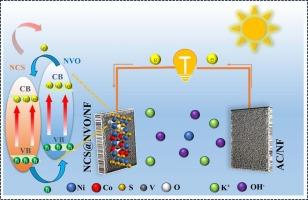Solar-driven induced photoelectron remember effect involved in core–shell NiCo2S4@Ni3V2O8 composite electrode with superior electrochemical energy storage for asymmetric supercapacitor
IF 9.9
1区 工程技术
Q1 ENERGY & FUELS
引用次数: 0
Abstract
Photo-assisted supercapacitor systems offer a compelling approach to effectively harnessing both solar and electrical energy. In this study, the core–shell heterostructure NiCo2S4@Ni3V2O8 (NCS@NVO) was successfully synthesized for the development of photosensitive supercapacitor electrodes. NCS@NVO demonstrated a pronounced photoelectron memory effect under illumination, attributed to the solar-driven contributions of both NCS and NVO, as photon absorption facilitated electron-hole pair separation and transport. Compared to the specific capacitance in the dark (2292F g−1 at 1 A g−1), the capacitance of the NCS@NVO composite electrode increased dramatically to 3025F g−1 when exposed to light. Moreover, the capacitance retention rate remained remarkably high at 99.83 % after 10,000 cycles at 20 A g−1. In addition, the NCS@NVO hybrid supercapacitor achieved an outstanding energy density of 63.56 W h kg−1 under illumination, alongside a power density of 789.84 W kg−1. This study thoroughly investigated the solar-induced photoelectron memory effect in the NCS@NVO composite electrode for asymmetric supercapacitors, paving the way for the design of high-performance photosensitive nano-electrodes in advanced electrochemical energy storage applications.

用于非对称超级电容器的核壳 NiCo2S4@Ni3V2O8 复合电极具有优异的电化学储能性能,其中涉及太阳能驱动的诱导光电子记忆效应
光辅助超级电容器系统为有效利用太阳能和电能提供了一种引人注目的方法。本研究成功合成了核壳异质结构 NiCo2S4@Ni3V2O8(NCS@NVO),用于开发光敏超级电容器电极。由于光子吸收促进了电子-空穴对的分离和传输,NCS@NVO 在光照下表现出明显的光电子记忆效应。与黑暗中的比电容(1 A g-1 时为 2292F g-1)相比,NCS@NVO 复合电极在光照下的电容急剧增加到 3025F g-1。此外,在 20 A g-1 下循环 10,000 次后,电容保持率仍高达 99.83%。此外,NCS@NVO 混合超级电容器在光照下的能量密度高达 63.56 W h kg-1,功率密度也达到了 789.84 W kg-1。该研究深入研究了用于不对称超级电容器的 NCS@NVO 复合电极中的太阳诱导光电子记忆效应,为设计先进电化学储能应用中的高性能光敏纳米电极铺平了道路。
本文章由计算机程序翻译,如有差异,请以英文原文为准。
求助全文
约1分钟内获得全文
求助全文
来源期刊

Energy Conversion and Management
工程技术-力学
CiteScore
19.00
自引率
11.50%
发文量
1304
审稿时长
17 days
期刊介绍:
The journal Energy Conversion and Management provides a forum for publishing original contributions and comprehensive technical review articles of interdisciplinary and original research on all important energy topics.
The topics considered include energy generation, utilization, conversion, storage, transmission, conservation, management and sustainability. These topics typically involve various types of energy such as mechanical, thermal, nuclear, chemical, electromagnetic, magnetic and electric. These energy types cover all known energy resources, including renewable resources (e.g., solar, bio, hydro, wind, geothermal and ocean energy), fossil fuels and nuclear resources.
 求助内容:
求助内容: 应助结果提醒方式:
应助结果提醒方式:


